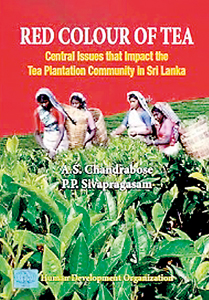The bitter reality behind that cuppa
By Dr. A.S. Chandrabose and P.P. Sivapragasam. Kandy: Human Development Organisation.
Price: Rs.500. Reviewed by Prof. Kalinga Tudor Silva
The main objective of this book is nicely captured in the title. We are typically familiar with the green and black colours of tea. As consumers we are familiar with the black colour and rich aroma of tea that comes in attractive packages these days. Tea workers, tourists and perhaps plantation companies are more familiar with the green of fresh tea leaves. However, the authors use their social and analytical skills and years of experience in working with estate workers, to bring out the red colour of tea as evident in the poor quality of life, oppressive living conditions and social deprivations of the tea workers of Sri Lanka.

The book is not so much a detached academic work but rather an outcome of activist research seeking to contribute towards improving the living conditions and rights of tea workers in Sri Lanka. Much of the research on the tea industry in Sri Lanka by agencies such as plantation companies, the Tea Research Institute, and Asian Development Bank has focused on issues like productivity, profitability and long-term sustainability of the sector while also paying attention to the labour problems in the plantation sector. In contrast, this work primarily focuses on the objectionable poor living conditions of the workers engaged in tea production.
Throughout the book the authors use the term “Indian Origin Tamils” (IOTs), rather than the conventional census category “Indian Tamil” which reportedly highlights their link to India without specifying their position in Sri Lanka society. According to the book, the problems of IOTs commence with their enumeration in the censuses. The 2001 census enumerated Indian Tamils to be 5.4% of the population.
Chandrabose and Sivapragasam argue that the actual number of IOTs may be underreported in the census due to the tendency among IOTs to declare themselves as Sri Lanka Tamil during census-taking to claim that they are indeed an indispensable section of the Sri Lanka population.
While this is perfectly understandable from the point of view of citizenship, the underreporting of the size of an ethnic group in the ethnicised society that Sri Lanka is today means that their lobbying and bargaining power vis-à-vis the Sri Lanka state and polity is below their actual potential given their true size. We need to await the results of the 2012 population census to determine if the position has changed at all, following the end of war and some degree of awareness raising within the community.
The tea workers make a substantial contribution to the economy of Sri Lanka in general and foreign exchange earning in particular. Nevertheless they remain at the bottom and periphery of social and economic development in Sri Lanka due to a variety of social class and ethnic processes that serve to entrench their inherited disadvantage vis-à-vis other groups in society. Furthermore, they were repeatedly attacked in waves of ethnic riots that culminated in the pogrom of 1983. This in turn led to their large scale displacement and movement to safer areas in Nuwara Eliya, the Northern Province and India. Also, due to language difficulties and insufficient integration of services in the estates with those in the country at large, the estate residents have not been able to benefit from the services of the Sri Lankan welfare state, free education and free health care in particular, to the extent they deserve given their historical background and inherited disadvantages.
According to this book, the red colour of tea is manifested in a number of social and economic indicators and disparities. For instance, in spite of some notable housing improvement in the estate sector in recent times, over 50% of estate residents still live in congested ‘labour lines’ built by planters in the colonial era. From 1990 onwards, the highest head count ratio as an index of absolute poverty is consistently reported by the estate sector, compared to rural and urban sectors as evident from Household Income and Expenditure Surveys conducted by the Department of Census and Statistics. According to World Bank statistics, the estate sector records the highest malnutrition levels among children judging by birth weight, weight according to age and height. The literacy levels and infant mortality rates in the estates have improved substantially over the past three decades or so, but they continue to be substantially lower relative to other sectors in the country.
On the whole the estate sector remains underdeveloped in terms of a variety social and health indicators compared to the rest of the country.
Even though the book is concerned with the macro-situation affecting the workers in general, there is some attention paid to the problems affecting women in the estates. Male domination is entrenched not only at the household level, but also in estate management, work organization and even in the trade union movement expected to work towards improving living and working conditions of the tea workers. While the women work long hours within the household, more or less the same situation is replicated in labour organisation as well. Even though theoretically there are equal wages for men and women workers in the estates the work norms for women workers engaged in tea plucking are more stringent and more demanding, compelling them to work longer hours compared to males for the standard wages.
Women have limited agency in decision-making in matters directly and intimately affecting them such as sexuality and reproductive health. LRT as a permanent birth control method to be adopted by women has been aggressively pushed by relevant agencies without examining its serious implications for their wellbeing and psychosocial health. The chronic nutritional deficiencies of women are reproduced among their children in the form of low-birth weight. Women are the primary victims of domestic violence triggered by alcoholism among their male partners. On the other hand sexual and physical abuse of domestic servants of estate origin employed in middle-class urban homes point to another dimension of gender-based violence affecting women of estate origin.
While there are some important positive developments in the estate sector such as expansion of educational opportunities and improved housing, this study shows that these developments have by no means altered the social exclusion and marginality of IOTs historically determined on the basis of inherited disadvantage derived from a complex mix of social class, ethnicity and gender-based inequality. In my view the study tends to ignore some relevant issues such as alcohol abuse in the estates, domestic violence, caste dynamics and difficulties encountered by estate residents in obtaining identity documents needed for various official transactions.
The study could have benefited from a more sophisticated analytical framework and a more rigorous combination of qualitative and qualitative research procedures, inclusive of focus group discussions, case histories and the like, but these limitations should not take away from its the merits and its relevance for social and political activists working in the plantation sector as well as for policy makers and programme administrators concerned with the welfare of estate residents.
Finally, the book forcefully drives home the fact that beneath every refreshing cup of tea that we daily consume, there is a bitter social and economic reality that should not escape our attention as socially aware and concerned citizens and consumers.
(The reviewer is attached to the University of Peradeniya)
Follow @timesonlinelk
comments powered by Disqus

























